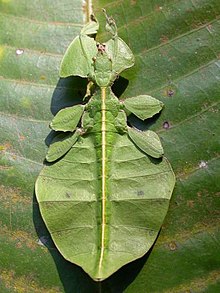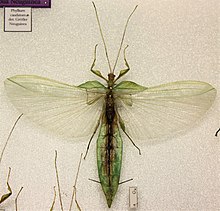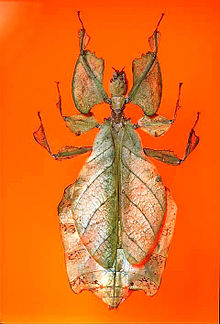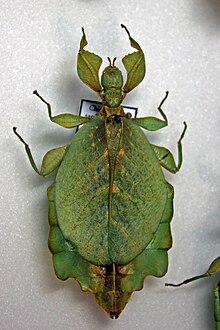Phylliidae
| Leaf insects Temporal range: Eocene - Recent
| |
|---|---|

| |
| Pulchriphyllium from the Western Ghats | |
| Scientific classification | |
| Kingdom: | Animalia |
| Phylum: | Arthropoda |
| Class: | Insecta |
| Order: | Phasmatodea |
| Suborder: | Euphasmatodea |
| Superfamily: | Phyllioidea Brunner von Wattenwyl, 1893 |
| Family: | Phylliidae Brunner von Wattenwyl, 1893 |
| Genera | |
|
see text | |
The family Phylliidae (often misspelled Phyllidae) contains the extant true leaf insects or walking leaves, which include some of the most remarkably camouflaged leaf mimics (mimesis) in the entire animal kingdom. They occur from South Asia through Southeast Asia to Australia. Earlier sources treat Phylliidae as a much larger taxon, containing genera in what are presently considered to be several different families.[1]
Characteristics[]
Leaf insects are camouflaged taking on the appearance of leaves. They do this so accurately that predators often are not able to distinguish them from real leaves. In some species, the edge of the leaf insect's body even has the appearance of bite marks. To further confuse predators, when the leaf insect walks, it rocks back and forth, to mimic a real leaf being blown by the wind.[2]

The scholar Antonio Pigafetta probably was the first Western person to document the creature. Sailing with Ferdinand Magellan's circumnavigational expedition, he studied and chronicled the fauna on the island of Cimbonbon as the fleet hauled ashore for repairs. During this time he documented the Phyllium species with the following passage:[3]
In this island are also found certain trees, the leaves of which, when they fall, are animated, and walk. They are like the leaves of the mulberry tree, but not so long; they have the leaf stalk short and pointed, and near the leaf stalk they have on each side two feet. If they are touched they escape, but if crushed they do not give out blood. I kept one for nine days in a box. When I opened it the leaf went round the box. I believe they live upon air.[4]
Tribes, genera and species[]
| |||||||||||||||||||||||||||||||||||||||||||||||||||||||||
| Relationships of the genetic analysis examined Phylliidae genera according Bank et al. & Cumming et al. (2021)[5][6] |
The Phasmida Species File (V. 5.0) lists the following in two tribes:[7]
Phylliini[]
Auth. Brunner von Wattenwyl, 1893
- Stål, 1875 (Pacific)
- (Westwood, 1864)
- , 1906
- (Blanchard, 1853) - type species (as Phyllium lobiventre Blanchard)
- , Le Tirant & , 2019 (Australasia)
 , male from the collection of D. Größer
, male from the collection of D. Größer- Redtenbacher, 1906) - type species (as Phyllium caudatum Redtenbacher)
- (Cumming, Le Tirant & Hennemann, 2019)
- (van de Kamp & Hennemann, 2014)
- Cryptophyllium Cumming, Bank, , , Le Tirant, Dong, Soner & , 2021 (SE Asia).
Selected species:- Cryptophyllium athanysus Westwood, 1859
- Cryptophyllium celebicum (De Haan, 1842) - type species (as Phyllium celebicum Haan, W. de)
- Cryptophyllium westwoodii (Wood-Mason, 1875)
- Zompro, 2001 (Northern Philippine Islands)
- Cumming, 2017
- Zompro, 2001 - type species

- Phyllium Illiger, 1798 (Sundaland, Philippine Islands, Wallacea, Australasia).
Selected species:- Phyllium bilobatum Gray, G.R., 1843
- Phyllium hausleithneri , 1999
- Phyllium jacobsoni Rehn, J.A.G. & , 1934
- Phyllium letiranti Cumming & Teemsma, 2018
- (Linnaeus, 1758) - type species (as Gryllus siccifolius Linnaeus)
- Cumming, 2017 (Northern Philippine Islands)
- Pseudomicrophyllium geryon (Gray, G.R., 1843)
- (Rehn, J.A.G. & Rehn, J.W.H., 1934) - type species (as Pseudomicrophyllium faulkneri Cumming)
- Pulchriphyllium Griffini, 1898 (Sundaland, continental Asia)
Selected species:- Pulchriphyllium bioculatum (Gray, G.R., 1832)
- Pulchriphyllium giganteum (Hausleithner, 1984)
- (Serville, 1838) - type species (as Phyllium pulchrifolium Serville)
- Cumming, Le Tirant & Büscher, 2021 (Pacific), female from the collection of D. Größer
- (Sharp, 1898) - type species (as Phyllium brachysoma Sharp)
- (Redtenbacher, 1906)
- Grösser, 2008)
- Cumming, Thurman, Youngdale & Le Tirant, 2020 (Australasia)
- (Cumming, Thurman, Youngdale & Le Tirant, 2020)
- (Brock & Hasenpusch, 2002)
- (Grösser, 2001) - type species (as Phyllium zomproi Grösser)
Nanophylliini[]

Distribution: Australasia, New Guinea; auth. Zompro & Grösser, 2003
- (Redtenbacher, 1906)
- Zompro & Grösser, 2003
- Grösser, 2002
- Cumming, Le Tirant & Teemsma, 2018
- Nanophyllium brevipenne (Grösser, 1992)
- (Grösser, 1992)
- Cumming, Le Tirant, Teemsma, Hennemann, Willemse & Büscher, 2020
- (Redtenbacher, 1906)
- Brock & Grösser, 2008
- (Karny, 1914)
- Cumming, 2017
- Cumming, Le Tirant, Teemsma, Hennemann, Willemse & Büscher, 2020
- (Redtenbacher, 1906) - type species
- Brock & Grösser, 2008
- Cumming, 2016
- (Grösser, 2008)
Captivity[]
Several species have gained in popularity as pets including Cryptophyllium celebicum, Cryptophyllium westwoodii, Phyllium jacobsoni, , , Phyllium letiranti, , Phyllium philippinicum , , , Pulchriphyllium bioculatum and Pulchriphyllium giganteum .
Extinct species[]
A 47-million-year-old fossil of Eophyllium messelensis, a prehistoric ancestor of Phylliidae, displays many of the same characteristics of modern leaf insects, indicating that this family has changed little over time.[8]
References[]
- ^ Bradley, J.C.; Galil, B.S. (1977). "The taxonomic arrangement of the Phasmatodea with keys to the subfamilies and tribes". Proceedings of the Entomological Society of Washington. 79 (2): 176–208.
- ^ Hidden Beauty (Archived)
- ^ Bergreen, Laurence (2003). Over the Edge of the World: Magellan's Terrifying Circumnavigation of the Globe. William Morrow. ISBN 0-06-621173-5.
- ^ Pigafetta, Antonio. "Anthony Pigapheta, Patrician of Vincenza, and King of Rhodes, to the very illustrious and very excellent Lord Philip de Villers Lisleaden, the famous Grand Master of Rhodes, his most respected Lord." Alderley, Lord Stanley of. The First Voyage Round the World, by Magellan. New York: Burt Franklin, n.d. 35-163.
- ^ Bank, S.; ; Li, Y.; Henze, K.; Le Tirant, S. & (2021) A tree of leaves: Phylogeny and historical biogeography of the leaf insects (Phasmatodea: Phylliidae)
- ^ Cumming, R. T.; Le Tirant, S. & Büscher, T. H. (2021) Resolving a century-old case of generic mistaken identity: polyphyly of Chitoniscus sensu lato resolved with the description of the endemic New Caledonia Trolicaphyllium gen. nov. (Phasmatodea, Phylliidae), ZooKeys 1055: 1–41 (2021), doi:10.3897/zookeys.1055.66796
- ^ ; Büscher, T. H. & Baker, E. W.: Phasmida Species File (Version 5.0/5.0): Phylliidae, (accessdate 8 August 2021)
- ^ Wedmann, Sonja; Bradler, Sven; Rust, Jens (9 January 2007). "The first fossil leaf insect: 47 million years of specialized cryptic morphology and behavior". Proceedings of the National Academy of Sciences. 104 (2): 565–9. doi:10.1073/pnas.0606937104. PMC 1766425. PMID 17197423.
External links[]
 Media related to Phylliidae at Wikimedia Commons
Media related to Phylliidae at Wikimedia Commons- Phasmid Study Group: Phylliidae
- Phasmatodea families
- Phylliidae
- Taxa named by Ludwig Redtenbacher

